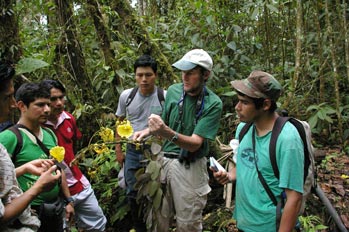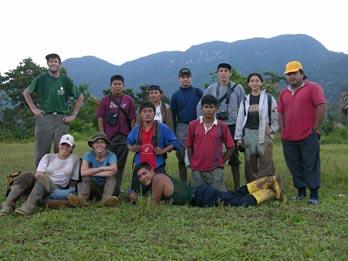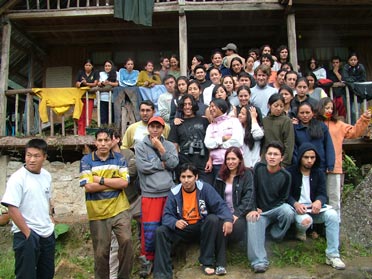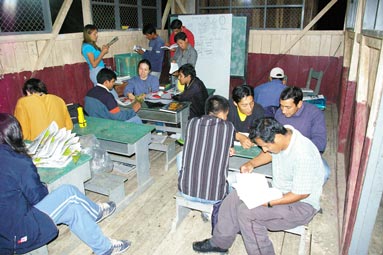 |
QUICK SEARCH
MO PROJECTS:
Africa
Asia/Pacific
Mesoamerica
North America
South America
General Taxonomy
Photo Essays
Training in Latin
America
MO RESEARCH:
Wm. L. Brown Center
Bryology
GIS
Graduate Studies
Research Experiences
for Undergraduates
Imaging Lab
Library
MBG Press
Publications
Climate Change
Catalog Fossil Plants
MO DATABASES:
W³MOST
Image Index
Rare Books
Angiosperm
Phylogeny
Res Botanica
All Databases
INFORMATION:
What's New?
People at MO
Visitor's Guide
Herbarium
Jobs & Fellowships
Symposium
Research Links
Site Map
Search
Dendrology Courses
What is Dendrology? Dendrology is a branch of systematic botany with practical applications: the term applies especially to the identification of living trees in the forest, rather than from dried herbarium specimens, using in part the vegetative characters of leaves, bark, exudates, tree archictecture, etc., to identify standing forest trees to family or genus level, when flowers or fruits are not available for examination by the student. Dendrology is a considerable challenge in species-rich Neotropical forests. David Neill, the Principal Investigator, has taught dendrology courses in Amazonian Ecuador since the mid-1980s on an annual basis, and also on some occasions in Ecuador. The dendrology course programs include discussion of tropical forest ecology, animal-plant interactions and the history of economic uses of trees throughout the New World tropics, but especially the Amazon basin and the Andes. This project was the first time that dendrology courses were held in the Cordillera del Cóndor region, where the forest composition and structure are quite distinct from the forests typical of lowland Amazonian Ecuador. Besides the classroom lectures and field practice in tree identification, the dendrology courses involved the participants in a research activity that added to their learning experience: all participants aided in the establishment of one or two one-hectare forest inventory plots during each course. In each plot, all trees with a diameter at breast height (DBH) of 10 cm or greater, are measured, marked with permanent aluminum tags, and identified. Voucher specimens are collected from at least one tree of each species in the plot, and for the trees that cannot be identified to species on sight. Three dendrology courses were originally scheduled for this project, to be held in the northern, central and southern sections of the Cordillera del Cóndor, with one course during each year of the project. The courses were originally planned for groups of twelve university-level students at each course: six from Ecuador and six from Peru. We actually held four courses, not three, and each course included 25 to 60 students, so we were able to reach a much larger audience of students than originally planned – a total of 170 students in the four courses. The participating students included practicing foresters and rural community members who are involved in forest management and conservation, as well as university-level biology students. Each course was 15-20 days in duration in the field, with post-field work to identify plant specimens from the course in the herbaria of Quito and Loja.
Dendrology Course # 1 September 2005 The first dendrology course was held at the indigenous Shuar communities of Kuankus and Yunkumas, in the Río Coangos watershed in the northernmost section of the Cordillera del Cóndor in Morona-Santiago province. The site is a five-hour hike from the nearest roadhead, crossing footbridges over the Río Santiago and Río Zamora. The participants included six university students from Ecuador and six from Peru, as well as 15 indigenous Shuar from local communities who are engaged in forest management activities with the Shuar Federation. There were also six instructors and assistant instructors on the course, led by the project’s Principal Investigator. The entire group set up two one-hectare plots, on non-sandstone substrate at Kuankus at 670 m elevation, and on the sandstone plateau of Yunkumas at 1150 m elevation. The latter site involved a further 5-hour hike to the top of the plateau where the entire group camped out for a week in order to complete the tree plot inventory. Following the field work, most of the participants travelled to Quito and participated in the identification of the tree specimens at the National Herbarium of Ecuador.
Dendrology Course # 2 May 2006 The second dendrology course was held at the Cabañas Yankuam eco-tourist lodge, on the banks of the upper Río Nangaritza in the southern portion of the Cordillera del Cóndor, in Zamora-Chinchipe province, Ecuador,near the mestizo village of Las Orquídeas. On this occasion, the entire group of 60 students were from the 4th-year botany class at the Universidad Central del Ecuador in Quito. The course was organized by their botany professor, Mercedes Asanza, and taught by David Neill. In addition to attending the dendrology lectures and field activities, each student carried out an individual research project with two days of field work, on different aspects of the flora at this site. The students prepared posters and oral presentations of their research projects, which were presented in a symposium at the biology school of the Universidad Central del Ecuador. The participants in the second dendrology course established two one-hectare plots in the “Tepui Conservation Area” that is administered by the village association of Las Orquídeas: one plot on a slope just above the Río Nangaritza and below the sandstone plateau at 920 m elevation, and a second one-hectare plot at 1120 m elevation atop the sloping sandstone plateau.
Dendrology Course # 3 November 2006 The third dendrology course, like the first one, included university students from Ecuador and Peru – six students from each country – as well as 15 participants from local communities in the region, indigenous Shuar as well as non-indigenous mestizos, who are engaged in forest management and conservation activities in the Cordillera del Cóndor region. The course was hosted by the mestizo village of Las Orquídeas, on the upper Río Nangaritza in Zamora-Chinchipe province. Dendrology class lectures were held in the village two-room schoolhouse. This group established a third one-hectare forest inventory plot in the “Tepui Conservation Area” on the sandstone plateau above Las Orquideas, at 1620 m elevation on the upper portion of the sloping plateau. The group also revised and completed the tree inventories in the two tree plots at Las Orquídeas by the participants in the second dendrology course. Dendrology Course # 4 April 2007 The fourth and final dendrology course, like the second course, was comprised mostly of 4th year botany students from Mercedes Asanza´s class at the Universidad Central del Ecuador, at total of 35 students. This course was held in the central portion of the Cordillera del Cóndor, in the Río Quimi watershed, in northernmost Zamora-Chinchipe province. The course was generously hosted at the field camp of EcuaCorriente. S.A., an Ecuadorian copper-mining company that is a subsidiary of a Canadian company, Corriente Resources, Inc., The company has plans to develop a large open-pit copper mine at the site, on the granitic rock below the sandstone plateau that, in this region, forms the crest of the Cordillera del Cóndor at 1800-2000 m and delineates the international boundary between Ecuador and Peru. As in the second dendrology course, the 4th year students from the Universidad Central del Ecuador each conducted a 2-day individual research project on different aspects of the flora in the area, besides participating in the dendrology lectures and practicums. The group established the sixth and final one-hectare forest inventory plot of the NSF-supported project, along a ridge at 1100 m elevation above the copper company field camp.
|
© 1995-2025 Missouri Botanical Garden, All Rights Reserved
4344 Shaw Blvd.
St. Louis, MO 63110
(314) 577-5100
Technical Support



